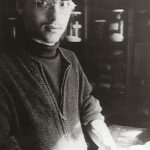Traveling the breath, Zen priest and yoga teacher Edward Espe Brown has found himself in some unexpected places.
When I began practicing awareness of the breath, I had no idea of the adventures that were in store, the strange and wondrous journeys that would unfold. Though I had envisioned scenic pictures of holy sites, I kept ending up in strange, out-of-the-way places: parts of my body I hadn’t yet met, feelings which had been dormant an age.
Being aware of the breath sounds simple. But initially my awareness did not stay on the job. It had a lot of thinking to do, a lot of judging, remembering, planning, reminiscing, script writing: Let’s figure this enlightenment thing out, and get an edge. Let’s identify the pathogen and kill it. What’s a mind for, after all? Shouldn’t “I” be running things?
Yet wouldn’t it be refreshing not to get caught up in all those scenarios of things to get done or make right? What about breathing easy, reposing in the present, at home in body and mind?
Although my experience with awareness of the breath is primarily in the context of meditation, I have also worked with the breath in the context of yoga asanas. In reviewing my experience, I would suggest that there are three basic modes of breath awareness: mindfulness of the breath-that is, allowing the breath to unfold or inform; emphasis on changes in posture that invite the breath to fill or expand into newly created spaces; and direct “changing” of the breath-pranayama.
Basic mindfulness of the breath is to be aware of the sensations of inhalation and exhalation without fixing, adjusting, improving or changing the breath. As much as possible you follow the breath, allowing it to be however long or short, deep or shallow, rough or smooth it is. Sometimes, with concentrated practice, a tremendous sense of calm and well-being arises, as though the breath opens, releases and lets go, no longer concerned with protecting and defending itself from your telling it what to do and how to be. What a relief. Why didn’t we think of this sooner?
At times I have been startled to discover the ways in which I was limiting my breath without being aware of it. Why am I holding my back rigid and breathing only in the front? Couldn’t I allow my back to breath as well as the front? After years of involuntary movements in meditation, an especially important breakthrough for me was realizing that I was holding the floor of my pelvis rigid. Completing the exhalation meant allowing the bottom to “fall out.” I could sit on the cushion instead of keeping the floor of my pelvis solid. Welcome to the bottomless ground.
I also discovered that the breath has a marvelous capacity to ease pain and soften tension. Eventually I learned that I could check to see if there were any sensations of breath in the areas of my body where I felt pain, stiffness and tightness, and I could allow the breath to gently touch the difficulty. I could simply breathe with the problem, rather than walling it off, pulling away from it or pushing it away. Following the breath encourages awareness to make wholesome choices, such as living with your pain, rather than hurting or hating yourself.
This is true in yoga as well: how wonderfully awakening it is to breathe into the stiffness and the tightness and allow the breath to soften and relieve, to open and facilitate stretch. Also to adjust the stretch in order to breathe, and breathe with focused awareness.
While studying the breath can invite changes in posture, changing the posture also invites the breath to shift, to open and expand into the new shape of the body, whether in upright sitting or in yoga poses. Our sense of self can be seen as closely associated with our habitual posture, and as we encourage the breath to fully agree to embody the new postures, we are agreeing, rather literally, to be more flexible, less tight, more fluid, to take on various shapes. We discover places in the body we didn’t know were there. We have greater freedom, since we are no longer limited to a more singular repertoire of postures.
Of course part of this work means encountering the rules implicit in how our body was structured, and feeling emotions we had agreed never to experience again. What was in the dark of the body comes to light. We breathe. We grow.

